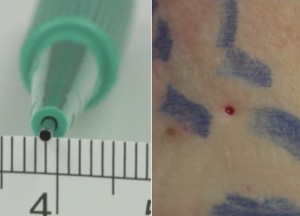Traditionally, varicose veins are removed through a short skin incision. These can leave scars, especially if the skin is stretched with forceps to grab the vein. Hooks to pull out the varicose veins have been a significant advance and are in common practice today. Furthermore, the skin incisions can be planned along the long axis of the collagen fibres to reduce scarring. Rubber stamps that print an ink circle on a flexed leg become elliptical when the leg is straightened. This helps to guide the surgeon in planning the incision along the long axis of the ellipse thereby minimising damage to the collagen fibres. Strategies in minimising the scarring associated with phlebectomies are continuously evolving.
HAROUN GAJRAJ I have performed over 2,000 phlebectomies using the 1 mm punch biopsy instrument since 2008 with the aim of improving the cosmetic outcome. This is a cylindrical knife with a handle at the other end. It is placed directly over the varicose vein and by pressing down with a twisting action it removes a 1 mm disc of skin to expose the varicose vein underneath. Phlebectomy scars can be troublesome in some patients, especially if a small linear skin incision is stretched or torn at the ends of the wound. This stretching may lead to post-inflammatory hyperpigmentation (PIH). The punch technique offers an even distribution of forces as the vein is pulled out. This leads to improved healing, less pigmentation and a 1 mm circular scar which contracts to become smaller. The end result is a scar that is hardly noticeable which may disappear after a few weeks.
